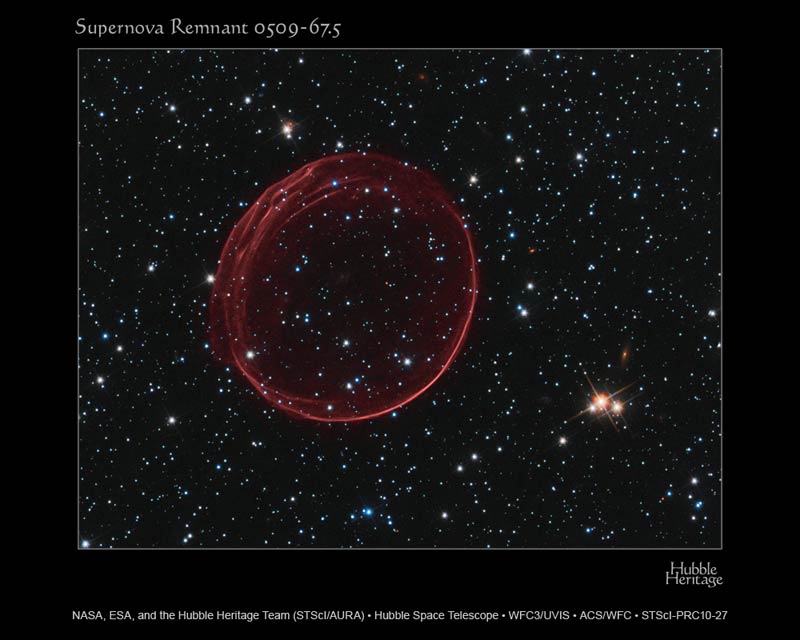Star Explosion Shines Like Christmas Ornament In Hubble Photo

NASA's Hubble Space Telescope has photographed what lookslike a festive holiday bauble in space ? a delicate sphere of gas floatingserenely in the cosmos.
The pristine shell is the visible remnant of a powerfulstellar explosion, or supernova, in the Large Magellanic Cloud, which is asmall galaxy about 160,000 light-years away from Earth. [Hubble's new spacebubble photo]
The festive bubble, formally known as SNR 0509-67.5 (or SNR0509 for short), is the result of gas that is being shocked by the expandingblast wave from the supernova explosion.
Astronomers think the stellar explosion was a Type Ia supernova,which is an especially energetic and bright variety. Type Ia events are thoughtto result from a white dwarf star in a binary, or two-star, system that robsits partner of material, taking on more mass than it is able to handle, which eventuallyresults in a violent explosion.
The rippling effect that can be seen in the shell's surfacemay be caused by subtle variations in the density of the surroundinginterstellar gas, the researchers said. The undulations could also be drivenfrom the interior of the bubble by pieces of the ejecta. ?
The sphere of gas measures about 23 light-years across, andis expanding at more than 11 million mph (about 18 million kph).
The Hubble Space Telescope's Advanced Camera for Surveysobserved the SNR 0509 supernova remnant on Oct. 28, 2006 using a filter that isolateslight from glowing hydrogen seen in the expanding shell. These observationswere then combined with visible light images of the surrounding star field thatwere capturedby Hubble on Nov. 4, 2010.
Get the Space.com Newsletter
Breaking space news, the latest updates on rocket launches, skywatching events and more!
As seen from Earth, the supernova ? which is about 400 yearsold ? might have been visible to southern hemisphere observers around the year1600.
There are, however, no known records of a "newstar" in the direction of the Large Magellanic Cloud near that time.
Decades earlier, famed 16th century astronomer Tycho Brahedid spot what he called a "new star" in the sky in 1527. That starturned out to be the supernova explosion of a star in the constellationCassiopeia, and was visible from the northern hemisphere, not southern.
A more recent supernova from that galaxy, called SN1987A, caught the eye of Earth viewers, and continues to be studied withground- and space-based telescopes, including Hubble.
- Images- 20 Years of the Hubble Space Telescope
- The 10 MostAmazing Hubble Discoveries
- 10Hubble Space Telescope Targets You Can Find Too
This story has been updated to correct the conversion error.
Join our Space Forums to keep talking space on the latest missions, night sky and more! And if you have a news tip, correction or comment, let us know at: community@space.com.

Space.com is the premier source of space exploration, innovation and astronomy news, chronicling (and celebrating) humanity's ongoing expansion across the final frontier. Originally founded in 1999, Space.com is, and always has been, the passion of writers and editors who are space fans and also trained journalists. Our current news team consists of Editor-in-Chief Tariq Malik; Editor Hanneke Weitering, Senior Space Writer Mike Wall; Senior Writer Meghan Bartels; Senior Writer Chelsea Gohd, Senior Writer Tereza Pultarova and Staff Writer Alexander Cox, focusing on e-commerce. Senior Producer Steve Spaleta oversees our space videos, with Diana Whitcroft as our Social Media Editor.











